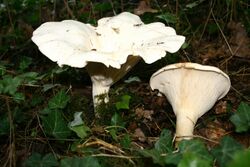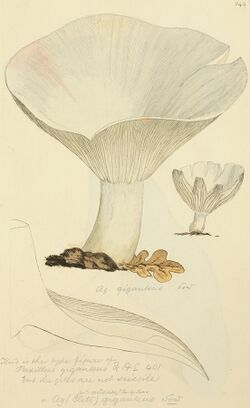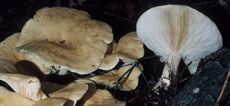Biology:Leucopaxillus giganteus
| Leucopaxillus giganteus | |
|---|---|

| |
| Scientific classification | |
| Domain: | Eukaryota |
| Kingdom: | Fungi |
| Division: | Basidiomycota |
| Class: | Agaricomycetes |
| Order: | Agaricales |
| Family: | Tricholomataceae |
| Genus: | Leucopaxillus |
| Species: | L. giganteus
|
| Binomial name | |
| Leucopaxillus giganteus (Sowerby) Singer (1939)
| |
| Synonyms | |
| |
| Leucopaxillus giganteus | |
|---|---|
| Mycological characteristics | |
| gills on hymenium | |
| cap is infundibuliform or flat | |
| hymenium is decurrent | |
| stipe is bare | |
| spore print is white | |
| ecology is saprotrophic | |
| edibility: edible but not recommended | |
Leucopaxillus giganteus, commonly known as the giant leucopax (formerly as the giant clitocybe) or the giant funnel, is a saprobic species of fungus in the family Tricholomataceae. As its common names imply, the fruit body, or mushroom, can become quite large—the cap reaches diameters of up to 50 cm (20 in). It has a white or pale cream cap, and is funnel-shaped when mature, with the gills running down the length of the stem. Considered by some to be a choice edible when young, this species has a cosmopolitan distribution, and is typically found growing in groups or rings in grassy pastures, roadside hedges, or woodland clearings. It has been shown to contain a bioactive compound with antibiotic properties.
Taxonomy
The species was first described as Agaricus giganteus by English naturalist James Sowerby in 1809, who illustrated it in his book Coloured Figures of English Fungi.[1] Other historical synonyms include Clitocybe gigantea (Quélet, 1872),[2] Paxillus giganteus (Fries, 1874),[3] and Omphalia geotropa var. gigantea (Quélet, 1886).[4] In 1934, Robert Kühner and Réné Maire created the genus Astropaxillus to contain species of Leucopaxillus with smooth spores, and they set L. giganteus as its type species.[5] American mycologist Rolf Singer transferred it to its current genus in 1938,[6] but recognized the value of maintaining a distinction of the smooth-spored species, and so made L. giganteus the type species of section Aspropaxilli.[7]
Leucopaxillus giganteus is commonly known as the 'giant leucopax' (formerly as the 'giant clitocybe') or the 'giant funnel'.[8]
Description
The cap of L. giganteus can become rather large, ranging from 10–50 cm (3.9–19.7 in), rarely even 70 cm (28 in) in diameter with a thickness of 1 to 1.4 cm (0.4 to 0.6 in) at half the radius.[9][10] Younger specimens have caps that are convex, with a margin that is rolled downwards, but as the mushrooms matures the cap flattens out and eventually becomes shallowly funnel-shaped. The cap is smooth and creamy white in color, but may develop brown stains and circular cracks with age.
The cream-colored gills are narrow, crowded close together, and have a decurrent attachment—running down the length of the stem; in age the gills will darken to a buff color. The stem is off-white with reddish-brown fibers and has dimensions, when mature, of 3 to 10 cm (1.2 to 3.9 in) tall and 2 to 5 cm (0.8 to 2.0 in) thick.[9][10] There is no ring on the stem. At the base of the stem there is typically a dense, white mycelium that may form a mat. The flesh is firm, and also is white.[11] Mature specimens are fragile, and difficult to remove from the ground without breaking.[12]
Microscopic characteristics
When viewed in deposit, such as with a spore print, the spores appear white.[13] When viewed with a light microscope, the spores are ovoid to ellipsoid, translucent (hyaline), have a smooth surface, and possess a broadly rounded apex and base; the spore dimensions are 6–8 by 3.5–5 µm. Like all Leucopaxillus species, the spores of L. giganteus are amyloid—meaning that they will absorb iodine when stained with Melzer's reagent—however, the extent of the stain may be variable.[14] The spore-bearing cells, the basidia, are 25–40 by 4.5–8 µm, narrowly club-shaped, and are attached to either 2 or 4 spores.[9] The hyphae of this species invariably have clamp connections.[11]
Similar species
Leucopaxillus giganteus somewhat resembles Leucopaxillus candidus, but this latter species has a darker coloring and is found more commonly in montane regions.[9] Leucopaxillus septentrionalis is also large and resembles L. giganteus at some points during its development, but may be distinguished by its nauseous odor, the tan color of the cap, and the adnate (gill squarely attached to the stem) to slightly adnexed (narrowly attached) gills.[15] L. candidus tends to be smaller, with a cap diameter ranging from 6 to 30 cm (2.4 to 11.8 in) broad.[11] Leucopaxillus albissimus, Leucopaxillus gentianeus, Lactarius vellereus, and Infundibulicybe gibba have been suggested as additional lookalike species.[10][16][17] Young specimens of L. giganteus may be confused with Clitocybe irina, C. praemagna or C. robusta.[18] White Lactarius and Russula species may also appear superficially similar, but they have brittle flesh that breaks cleanly, unlike the fibrous flesh of L. giganteus.[16]
Habitat and distribution
Leucopaxillus giganteus can form fairy rings in grassy areas like pastures,[19] and is also found along roadsides;[20] it produces fruiting bodies in summer and autumn.[21] It is a saprobic species, and so derives nutrients by decomposing organic matter.
The fungus has a cosmopolitan distribution,[13] and occurs throughout the temperate zone of the northern hemisphere.[22] It is found in North America, Britain, and Europe.[23] David Arora reports that in North America, it is most common in the Pacific Northwest and the Rocky Mountains.[18]
Uses
Edibility
The species is nonpoisonous but reportedly poor in flavor.[24] Although one source claims that it is a "choice edible when young",[13] another source warns of the possibility of stomach cramps and diarrhea.[20] Burrows suggests preparing specimens by cutting them up and boiling the pieces, and disposing of the water; then they may be used in dishes such as stews and casseroles.[25] Because of its large size, one specimen can be enough to be consumed by several individuals.[21] The odor has been said to be farinaceous or similar to fish meal;[11] the taste and smell of the mushroom have also been alternately characterized as "mild and pleasant" or "truly disgusting".[20] The species is also a favorite food for species of the fruit fly genus Drosophila.[26]
Bioactive compounds
Leucopaxillus giganteus contains a bioactive compound named clitocine that has antibiotic activity against a number of bacteria that are pathogenic to humans, such as Bacillus cereus and Bacillus subtilis;[27][28] an earlier (1945) study showed antibiotic activity against Mycobacterium tuberculosis, Salmonella typhi, and Brucea abortus.[29] Clitocine has also been shown to promote apoptosis (cell death) in human cervical cancer cells in vitro (HeLa).[30] The mycelia of L. giganteus, when grown in liquid culture, has been shown to produce phenols and flavonoids that have antioxidant activity.[31]
References
- ↑ Sowerby J. (1809). Coloured Figures of English Fungi. 4. London: R. Wilks. pp. 401–40. "in pl. 420"
- ↑ Quélet L. (1872). "Les Champignons de Jura et des Vosges" (in French). Mémoires de la Société d'Émulation de Montbéliard. II 5: 88.
- ↑ Fries EM. (1874) (in Latin). Hymenomycetes europaei sive epicriseos systematis mycologici. Uppsala: Typis descripsit ed. Berling. p. 401.
- ↑ Quélet L. (1886) (in Latin). Enchiridion Fungorum in Europa media et praesertim in Gallia Vigentium. p. 23. https://books.google.com/books?id=k2EVAAAAYAAJ&pg=PA23.
- ↑ "Étude de la réaction de la membrane sporique à l'iode dans les divers genres d'Agarics leucosporés" (in French). Bulletin de la Société Mycologique de France 50 (1): 9–24. 1934.
- ↑ Singer R. (1938). "De nonnullis Basidiomycetibus. I" (in Latin). Botanicheskie Materialy Otdela Sporovyh Rastenij Botanicheskogo Instituti Imeni V.L. Komarova 4 (10–12): 4–18.
- ↑ "A monograph on the genus Leucopaxillus Bours". Michigan Academy of Science, Arts, and Letters 28: 85–132. 1943.
- ↑ Phillips R. "Leucopaxillus giganteus". Rogers Mushrooms. http://www.rogersmushrooms.com/gallery/DisplayBlock~bid~6334~gid~.asp.
- ↑ 9.0 9.1 9.2 9.3 Flora Agaricina Neerlandica – 3. Boca Raton, Florida: CRC. 1995. p. 77. ISBN 978-90-5410-616-6. https://books.google.com/books?id=NGGiXsS9eYwC&pg=PA76.
- ↑ 10.0 10.1 10.2 Davis, R. Michael; Sommer, Robert; Menge, John A. (2012). Field Guide to Mushrooms of Western North America. Berkeley: University of California Press. pp. 149–150. ISBN 978-0-520-95360-4. OCLC 797915861. https://www.worldcat.org/oclc/797915861.
- ↑ 11.0 11.1 11.2 11.3 North American Mushrooms: A Field Guide to Edible and Inedible Fungi. Guilford, Connecticut: Falcon Guide. 2006. p. 118. ISBN 978-0-7627-3109-1. https://books.google.com/books?id=zjvXkLpqsEgC&pg=PA118.
- ↑ Kuo M. "Clitocybe gigantea / Leucopaxillus giganteus". MushroomExpert.Com. http://www.mushroomexpert.com/clitocybe_gigantea.html.
- ↑ 13.0 13.1 13.2 Schalkwijk-Barendsen HME. (1991). Mushrooms of Western Canada. Edmonton, Alberta: Lone Pine Publishing. p. 260. ISBN 978-0-919433-47-2. https://archive.org/details/mushroomsofweste0000scha/page/260.
- ↑ "Basidiospore form in the British Leucopaxillae". Kew Bulletin 28 (3): 365–79. 1973. doi:10.2307/4108880.
- ↑ Smith AH. (1975). A Field Guide to Western Mushrooms. Ann Arbor, Michigan: University of Michigan Press. p. 86. ISBN 978-0-472-85599-5. https://books.google.com/books?id=q7eXGZQG7ksC&pg=PA129.
- ↑ 16.0 16.1 (in French) Encyclopédie visuelle des champignons. Chamalières, France: Editions Artemis. 2005. p. 158. ISBN 978-2-84416-399-8. https://books.google.com/books?id=5uDPawn3pJwC&pg=PA158.
- ↑ (in French) Champignons. L'encyclopédie. Chamalières, France: Editions Artemis. 2002. p. 235. ISBN 978-2-84416-145-1. https://books.google.com/books?id=zRH1yzMYsx4C&pg=PA235.
- ↑ 18.0 18.1 Arora D. (1986). Mushrooms Demystified: A Comprehensive Guide to the Fleshy Fungi. Berkeley, California: Ten Speed Press. pp. 158–59. ISBN 978-0-89815-169-5. https://books.google.com/books?id=S-RmabYsjI4C&pg=RA1-PA949.
- ↑ Kaiser P. (1998). "Relations of Leucopaxillus giganteus, basidiomycete of fairy rings, with soil microflora and grassland plants". Cryptogamie, Mycologie 19 (1–2): 45–61. ISSN 0181-1584. http://serials.cib.unibo.it/cgi-ser/start/it/spogli/df-s.tcl?prog_art=1083110&language=ENGLISH&view=articoli.
- ↑ 20.0 20.1 20.2 Hall IR. (2003). Edible and Poisonous Mushrooms of the World. Portland, Oregon: Timber Press. p. 159. ISBN 978-0-88192-586-9.
- ↑ 21.0 21.1 "Leucopaxillus giganteus mycelium: effect of nitrogen source on organic acids and alkaloids". Journal of Agricultural and Food Chemistry 56 (12): 4769–74. 2008. doi:10.1021/jf8001526. PMID 18494481.
- ↑ Mushrooms and other Fungi. London, UK: Peter Nevill. 1961. pp. 49–50.
- ↑ Kibby G. (2006). Guide to Mushrooms and Toadstools of Britain and Europe (Philips Guide). London, UK: Philip's. p. 137. ISBN 978-0-540-08936-9.
- ↑ Miller Jr., Orson K.; Miller, Hope H. (2006). North American Mushrooms: A Field Guide to Edible and Inedible Fungi. Guilford, CN: FalconGuide. pp. 118. ISBN 978-0-7627-3109-1.
- ↑ Burrows I. (2005). Food from the Wild. New Holland Publishers. p. 109. ISBN 978-1-84330-891-1. https://books.google.com/books?id=j470CrsOuPQC&pg=PA109.
- ↑ Kimura MT. (1980). "Evolution of food preferences in fungus-feeding Drosophila: An ecological study". Evolution 34 (5): 1009–18. doi:10.2307/2408009. PMID 28581130.
- ↑ Müller-Stoll WR. (1990). "The antibiotic activity of clitocybine and nebularine from Leucopaxillus giganteus and Clitocybe nebularis". Zeitschrift für Mykologie 56 (1): 167–86. ISSN 0170-110X.
- ↑ Barros L; Baptista P; Estevinho LM; Ferreira ICFR (2007). "Bioactive properties of the medicinal mushroom Leucopaxillus giganteus mycelium obtained in the presence of different nitrogen sources". Food Chemistry 105 (1): 179–86. doi:10.1016/j.foodchem.2007.03.063.
- ↑ Hollande AC. (1945). "Lyse massive des bacilles de Koch chez la Cobaye après traitement à la clitocybine. Pouvoir inhibiteur de ce produit vis-à-vis du bacille typhique, du colibacille, de Brucella abortus etc" (in French). Comptes Rendus de l'Académie des Sciences 221: 361–63.
- ↑ "Anti-proliferative effect of clitocine from the mushroom Leucopaxillus giganteus on human cervical cancer HeLa cells by inducing apoptosis". Cancer Letters 262 (2): 190–200. 2008. doi:10.1016/j.canlet.2007.12.013. PMID 18222036.
- ↑ Barros L; Ferreira ICFR; Baptista P. (2007). "Phenolics and antioxidant activity of mushroom Leucopaxillus giganteus mycelium at different carbon sources". Food Science and Technology International 14 (1): 47–55. doi:10.1177/1082013208090094.
Wikidata ☰ Q2454893 entry



